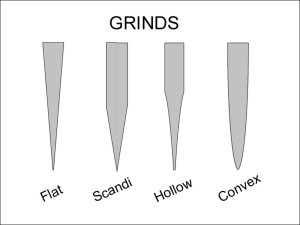This time, I will take you through some common “grinds” used in knife manufacture. There are several different kinds, and they all have their own uses and unique qualities. A grind is a synonym for an edge, and it is one of the most important and most interesting parts of a knife’s anatomy. These grinds include hollow grinds, (full) flat grinds, high flat grinds, chisel grinds, convex grinds, compound/double bevel grinds, and asymmetrical grinds. There is also another one called the sabre, V-, or Scandinavian, grind, which is a subdivision of the flat grind. This article will be discussing the first few types of knife grinds. Please check back in future weeks for part II of this discussion.
The Hollow Grind
The first sort of grind I will be describing today is the hollow grind. This is a common knife grind in blades currently on the market; it’s particularly valued by hunters and sportsmen for its keen edge and its versatility out in the wilderness when it comes to skinning the kill or preparing the meat after the hunt. Hollow grinds are very effective for cutting operations. The shape of the blade with a hollow grind is highly arched and slender, which helps the knife in performing such tasks. Yet you may find yourself sharpening it more than you would like to because the hollow grind, while powerfully penetrating, also becomes blunted fairly quickly, in comparison to other knife edges.
The Full Flat Grind
The full flat grind is a very basic grind structure with clean angles uncomplicated by bevels, which break up the lines of the blade. Nevertheless it must be said that bevels can give a more nuanced surface and functionality to the knife, which is a great benefit when you have a beveled edge. Back to full flat grinds, though–they are popular to use as culinary knives.
The High Flat Grind
The high flat grind, by contrast, has a bevel that starts partway down the blade; this grants it strength and adaptability for practical use not present in the full flat grind. The complexity of the high flat grind’s bevel gives it a nice advantage over the full flat grind. For this reason, a lot of knife makers have started to phase out full flat grinds in favor of high flat grinds.
The Sabre/Scandinavian/V-grind
The next knife grind I want to mention goes by several names, but they are all the same edge. It is known as the V-grind, sabre grind and Scandinavian grind. Again, this is a class of flat grind. The difference between this and the other two flat grind styles is that the bevel is found down towards the point; this adds to its level of precision when carrying out certain projects. Scandinavian/sabre/V-grinds are becoming a favorite among knife users and collectors for this reason, and also because they are an improvement upon the full flat grind’s basic form. The sabre/Scandinavian/V-grind is designed for situations such as when you’re roughing it in the outdoors, or even for less intense activities: enjoyable hobbies and crafts like woodworking. Be aware, however, that while this type of edge is simple to sharpen, it does wear out fast.
Be the first to see flash sales, giveaways, product announcements, and more!


